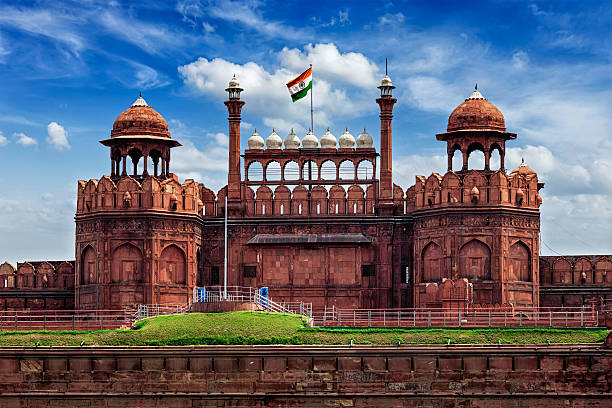The Red Fort (Lal Qila): A Symbol of India’s Heritage, Architecture, and Historical Significance
The Red Fort (Lal Qila) of India is one of the most iconic historical monuments of the country, located in the heart of New Delhi. A symbol of India's rich heritage and architectural brilliance, the fort stands as a testimony to the grandeur of the Mughal Empire. With its imposing structure, intricate design, and historical significance, the Red Fort is not only a UNESCO World Heritage Site but also a symbol of India’s struggle for independence and its cultural evolution.

Photo from:iStock
Historical Context and Significance
The construction of the Red Fort was initiated by Emperor Shah Jahan in 1638, when he decided to shift the Mughal capital from Agra to Delhi. The fort was completed in 1648, and its construction marked the beginning of a new era in Indian architecture. Shah Jahan’s vision was to create a magnificent structure that would reflect the glory of the Mughal Empire, and the Red Fort became the center of political and cultural life for the empire.
The fort's significance is not merely confined to its architectural beauty; it also holds historical importance as the seat of the Mughal emperors for around 200 years. It was from this fort that the emperors ruled over much of the Indian subcontinent. It was also here that India’s first Prime Minister, Jawaharlal Nehru, hoisted the Indian flag on August 15, 1947, marking the country's independence from British colonial rule.
Architectural Features and Design
The Red Fort is an example of the fusion of Persian, Timurid, and Indian architecture, known as Mughal architecture. The fort is constructed primarily from red sandstone, which is why it is called the Red Fort (Lal Qila). The fort's design incorporates traditional Islamic styles and Mughal influences, which are evident in the structure's arches, domes, and courtyards.
The fort covers an area of around 255 acres, and its walls stretch to about 2.5 kilometers in length. The walls are made of red sandstone and are up to 33 meters (108 feet) high, making the fort an imposing and visually striking structure. The fort is surrounded by a moat, which once served as a defensive measure, though it has since been dried up.
The fort's layout is divided into various sections, with several important structures and buildings scattered throughout the complex. Some of the most notable buildings inside the Red Fort are:
-
Diwan-i-Aam (Hall of Public Audiences): This hall was used by the Mughal emperors to address the general public. It is an open pavilion with 27 columns, and it was here that the emperor would sit and listen to petitions from the people. The marble platform in the center of the hall is where the emperor would sit, and it still retains its regal aura.
-
Diwan-i-Khas (Hall of Private Audiences): The Diwan-i-Khas was reserved for private meetings between the emperor and his closest advisors or nobles. It is one of the most exquisite structures in the fort, known for its intricate marble inlays and decorations. The famous Peacock Throne was once housed here, which was one of the most opulent thrones in history.
-
Moti Masjid (Pearl Mosque): Built by Emperor Aurangzeb, the Moti Masjid is a beautiful example of Mughal religious architecture. The mosque is made entirely of white marble and is a serene space within the fort, used by the emperor and his family for prayers.
-
Rang Mahal (Palace of Colors): The Rang Mahal was the emperor’s private quarters, known for its intricate frescoes and tilework. The palace was once adorned with rich colors and opulent decorations, creating a luxurious and artistic atmosphere.
-
Khas Mahal (Private Palace): This palace was the residence of the emperor and his family. It was a place of luxury and grandeur, with exquisite carvings, marble inlays, and beautiful courtyards.
-
The Baradari (Twelve-pillared Pavilion): This structure served as a meeting place for the Mughal nobility. It has twelve pillars and is a fine example of Mughal craftsmanship.

Photo from: Pexels
The Fort's Moat and Defensive Architecture
The Red Fort’s strategic location and defensive architecture were essential to its role as the center of Mughal power. The fort is surrounded by a large moat, and the entry gates are strategically designed to make it difficult for enemies to penetrate the fort. The Lahori Gate is the main entrance to the fort and is located on the western side. It is a large, imposing gate that was once heavily fortified. The Delhi Gate, which was used by the royal family, is located on the southern side.
The fort's design also included multiple layers of security, such as the high, thick walls and the use of a complex system of courtyards and buildings to confuse invaders. The fort’s design reflects a blend of military architecture and luxury, with spaces for both defense and royal pleasure.
Cultural and Artistic Influences
Mughal art and culture flourished under the reign of Shah Jahan, and the Red Fort is a testament to the period's opulence. The fort’s design incorporated elements of Persian, Central Asian, and Indian aesthetics, creating a rich and diverse architectural style. The use of marble, intricate inlay work, floral motifs, and ornamental designs reflects the era’s fascination with beauty and luxury.
The fort also served as a hub for cultural activities, such as poetry recitals, music performances, and courtly entertainments. The Mughal emperors were great patrons of the arts, and the fort's architecture and surroundings provided the perfect backdrop for these cultural activities.
The Red Fort After the Mughal Empire
Following the decline of the Mughal Empire in the 18th century, the Red Fort continued to serve as a royal residence under various rulers, but its importance gradually waned. The fort was captured by the Marathas in 1771 and later fell into the hands of the British East India Company after the Third Anglo-Maratha War in 1818.
During British rule, the fort became a symbol of colonial power, and several changes were made to the fort's structure. The British added new buildings, including barracks and offices, and altered some of the original Mughal designs. Despite these changes, the Red Fort remained an important symbol of India's colonial history.
The fort played a significant role during the Indian Rebellion of 1857, also known as the Indian Mutiny. The British forces captured the fort after a prolonged siege, and it became a symbol of the British victory. Following the rebellion, the British dismantled many of the fort’s structures and made efforts to suppress any symbols of rebellion. The fort remained under British control until India gained independence in 1947.
Independence and the Symbolic Significance of the Red Fort
On August 15, 1947, when India gained independence from British rule, the Red Fort became the site of the first ceremony of hoisting the Indian flag. Jawaharlal Nehru, the first Prime Minister of independent India, unfurled the Indian tricolor from the ramparts of the fort, marking the end of British rule in India. Since then, the Red Fort has been the venue for India's Independence Day celebrations every year, with the Prime Minister delivering a speech to the nation from the fort's ramparts.
This annual event has cemented the Red Fort’s status as a national symbol of India’s freedom, its historical struggle for independence, and the resilience of its people. The fort’s connection to the birth of the Indian republic adds to its symbolic significance.
Conservation and Preservation Efforts
The Red Fort's importance as a cultural and historical monument has led to numerous conservation and preservation efforts over the years. As a UNESCO World Heritage Site in 2007, the fort is protected and maintained by the Archaeological Survey of India (ASI). Despite the challenges posed by urbanization and the passage of time, the fort has managed to retain much of its original beauty and grandeur.
Over the years, various restoration projects have been undertaken to preserve the fort's architectural integrity. These efforts include the restoration of the Diwan-i-Khas, the Moti Masjid, and the Rang Mahal, among other structures. The government has also taken steps to improve the infrastructure surrounding the fort, including the creation of a museum that showcases the history and cultural significance of the fort.
The Red Fort Today: A Cultural and Tourist Destination
Today, the Red Fort is one of India's most visited tourist destinations. Visitors from all over the world come to admire its architectural beauty, historical significance, and cultural value. The fort houses several museums, including the Archaeological Museum and the Indian War Memorial Museum, which showcase India’s rich history and heritage.
In addition to its role as a tourist destination, the Red Fort also serves as a site for cultural events, exhibitions, and educational programs. The fort's historical significance and architectural splendor continue to captivate visitors, making it one of the most important monuments in India.
Conclusion
The Red Fort, or Lal Qila, is much more than just a fort; it is a symbol of India’s rich cultural heritage, its historical journey, and the resilience of its people. From its construction during the Mughal era to its role in India’s fight for independence, the fort has witnessed some of the most significant events in Indian history. Its blend of architectural brilliance, historical importance, and cultural significance makes it one of the most remarkable monuments in the world.
As a UNESCO World Heritage Site, the Red Fort stands as a testament to India’s glorious past and its continuous journey towards growth, freedom, and national identity. Its presence in the heart of New Delhi continues to inspire awe and admiration, attracting millions of visitors each year who come to explore its beauty and learn about its rich history.
